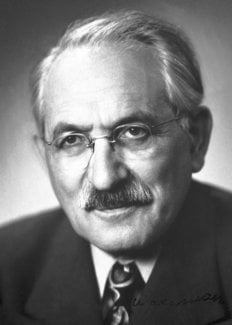Selman A. Waksman
Biographical

Selman Abraham Waksman was born in Priluka, near Kiev, Russia, on July 22nd, 1888, as the son of Jacob Waksman and Fradia London. He received his early education primarily from private tutors, and completed his school training in Odessa in an evening school and with private tutors. He obtained his matriculation diploma in 1910 from the Fifth Gymnasium in Odessa as an extern, and left for the United States immediately afterwards.
In the autumn of 1911 he entered Rutgers College, having won a State Scholarship the previous spring. He received his B.Sc. degree in Agriculture from Rutgers in 1915. He was then appointed research assistant in soil bacteriology under Dr. J. G. Lipman at the New Jersey Agricultural Experiment Station, and was allowed to continue graduate work at Rutgers, obtaining his M.Sc. degree in 1916. In the same year, he became a naturalized United States citizen and was appointed a Research Fellow at the University of California where he received his Ph.D. in Biochemistry in 1918.
He was invited by Dr. Lipman to return to Rutgers, where he received an appointment as microbiologist at the Experiment Station and as Lecturer in Soil Microbiology at the University. He was appointed Associate Professor in 1925 and Professor in 1930. When the Department of Microbiology was organized in 1940, he became Professor of Microbiology and Head of the Department. In 1949, he was appointed Director of the Institute of Microbiology. He retired in 1958. However, he has a laboratory and office at the Institute to continue a limited amount of research and considerable writing and lecturing.
Apart from his activities at Rutgers, he was invited to organize a division of Marine Bacteriology at the Woods Hole Oceanographic Institution in 1931; he was also appointed marine bacteriologist at the same institution, where he served until 1942. He was then elected as a Trustee, and later a Life Trustee. On various occasions, he held industrial positions for limited periods of time and served as consultant to industrial laboratories, government and other scientific institutions.
Professor Waksman’s fields of work include, in chronological order, the microbiological population of the soil, sulphur oxidation by bacteria, microorganisms and soil fertility; decomposition of plant and animal residues, nature and formation of humus; occurrence of bacteria in the sea and their role in marine processes; production and nature of antibiotic substances; taxonomy, physiology, and biochemistry of the actinomycetes. He has published more than 400 scientific papers and has written, alone or with others, 18 books.
He has isolated, together with his students and associates, a number of new antibiotics, including actinomycin (1940), clavacin, streptothricin (1942), streptomycin (1943), grisein (1946), neomycin (1948), fradicin, candicidin, candidin, and others. Two of these, streptomycin and neomycin, have found extensive application in the treatment of numerous infectious diseases of men, animals and plants. They have been covered by patents, that on streptomycin having been recently listed as one of the ten «patents that shaped the world».
Professor Waksman holds honorary doctor’s degrees in medicine, science, agriculture, law or letters from the Universities of Liège, Athens, Pavia, Madrid, Strasbourg, Jerusalem, Göttingen, Perugia, Keio (Japan) and several American universities and colleges. He is a member, honorary member or fellow of a number of scientific societies in the USA, France, Sweden, Mexico, India, Germany, Brazil, Spain, and Israel. He is a Former President of the American Society for Microbiology.
His work in the field of microbiology has been recognized by numerous scientific and other societies in the USA, Denmark, The Netherlands, Canada, Sweden, Japan, Israel, Italy, Spain, and Turkey. In 1950 he was made Commander of the French Légion d’Honneur, and in 1952 he was voted as one of «the most outstanding 100 people in the world today» (Little, Brown & Co.).
In 1949, the Trustees of Rutgers University voted to establish an Institute of Microbiology and made Professor Waksman its first Director. The larger portion of the funds derived from the royalties obtained from streptomycin and neomycin have been assigned for the building and support of this Institute, which is being used for research and advanced teaching on a doctorate and post-doctorate level in microbiology. Out of the small portion of the royalties assigned to him personally, Dr. and Mrs. Waksman established the «Foundation for Microbiology», for the support of research and publications in the field of microbiology at various institutions of the world. Professor Waksman continues as President of this Foundation. He and his wife have also established a scholarship for an immigrant student, or the son or daughter of an immigrant, at Rutgers University, and Mrs. Waksman has established a music scholarship at Douglass College, Rutgers University.
Professor Waksman’s wife is Deborah B. Mitnik. They have one son, Byron H. Waksman, M.D., who was a Research Associate at Massachusetts General Hospital, Boston, and Assistant Professor at Harvard University Medical School, and more recently Professor of Microbiology at Yale University Medical School, and two grandchildren, Nan and Peter.
This autobiography/biography was written at the time of the award and first published in the book series Les Prix Nobel. It was later edited and republished in Nobel Lectures. To cite this document, always state the source as shown above.
For more updated biographical information, see: Waksman, Selman Abraham, My Life With Microbes. Simon and Schuster, New York, 1954.
Selman A. Waksman died on August 16, 1973.
Nobel Prizes and laureates
Six prizes were awarded for achievements that have conferred the greatest benefit to humankind. The 12 laureates' work and discoveries range from proteins' structures and machine learning to fighting for a world free of nuclear weapons.
See them all presented here.
